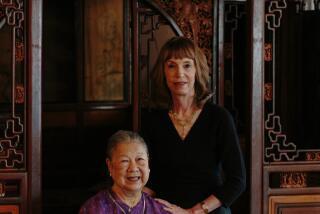On Missing the Madwoman in the Attic : THE BRONTES Charlotte Bronte and Her Family, <i> Rebecca Fraser (Crown: $25; 543 pp.) </i>
This is a tale of sound and fury, emanating from the walls of a lonely Yorkshire parsonage--a story that has been told innumerable times since Elizabeth Gaskell first published her classic biography of Charlotte Bronte in 1857. Now Rebecca Fraser, daughter of English biographer Antonia Fraser, tries her hand at retelling one of the great sagas of English literature in a new biography that focuses almost exclusively on Charlotte Bronte.
Fraser gracefully recapitulates the details of the legendary and enigmatic Bronte saga--the arrival at the parsonage at the isolated town of Haworth, the nightmare of the Cowan Bridge School, where the abusive regimen caused the death of Bronte’s eldest sisters, Maria and Elizabeth. The book is solidly researched and--in the parts pertaining to the middle of Charlotte’s life--compellingly written; especially deft are the chapters relating to Charlotte Bronte’s stay at the Pensionnat Heger in Brussels, her repressed passion for the charismatic Prof. M. Heger; and her foray into London’s literary world, after the startling success of “Jane Eyre.”
But “The Brontes” also disappoints in some important ways. It provides few new insights, and the writing lacks a crucial vividness. Fraser never quite succeeded in convincing me that she had been to Haworth, whose parsonage I remember so clearly from my own pilgrimage 15 years ago. I never really believed that she had gazed from those austere cramped rooms onto the encroaching cemetery, with its phalanxes of bizarrely slanting tombstones amid the morbid greenish light; or imbibed the peace the moors had conveyed to the Bronte women, all of whom died at the peak of their creativity, in their 30s.
But what I found most unsatisfying was Fraser’s neglect of the texts of the Bronte’s novels themselves in unraveling the anxieties, struggles and most of all the repressed anger of those troubled young women writers of genius--women born, it seems all too hauntingly clear today, 100 years before their time. In an age of feminist literary critique, I would have expected Fraser, 32, to integrate the explication of the Brontes’ literary work into the story of their lives with greater attention and sensitivity. To some extent Charlotte Bronte’s novels--considered rageful and immoral by many of her contemporaries, as Fraser points out--were the untamed Heathcliffs of her existence: To paraphrase a famous line from Emily Bronte’s “Wuthering Heights,” Charlotte’s novels were more herself than she was; and to neglect the nuances of their texts, and the psychological subscript of their language is akin to psychoanalyzing a patient without scrutinizing her dreams.
Only in the Brontes’ novels could Currer, Acton and Ellis Bell--the Brontes’ telling noms de plume--truly express what they felt; and what they felt was often construed as angry and shocking to the Victorian public. This is more easily remembered with regard to “Wuthering Heights,” which seemed to provoke in contemporary critics an almost universal lashing out against the book’s rough, “un-Christian,” “savage” atmosphere; but it is also true of “Jane Eyre,” which many contemporary readers found unsettling and unwomanly in its depiction of a governess who refused, in effect, to accept her lot by aspiring in all ways to be equal.
Fraser has chosen to emphasize the letters of Bronte acquaintances and friends, as well as Charlotte’s own vast body of correspondence (indeed the book grows in power commeasurably with the introduction of those letters). But given the considerable constraints of women in Victorian society, one doubts whether even the most private letters would ever be as trustworthy a map of Charlotte Bronte’s psyche as her novels, with their markedly hallucinatory cast; (works written, as Bronte herself recounts, with her eyes closed, in a trancelike spell). Only then did she escape the dictates of her powerful, egocentric father, first, and later, her husband Arthur Nicholls (whom I think Fraser treats too kindly). During the last year of her life, after her marriage, there was more overt inhibition forced upon her as well. As Fraser and other biographers have recounted, Charlotte Bronte’s husband Arthur Nicholls not only threatened to censor her letters, but demanded that her best friend, Ellen Nussey, burn those she received from his wife--an unconscionable request which Nussey, fortunately for literary history, ignored.
The lack of a personal and original approach is my major complaint with Fraser’s book: While it is competent, it is also repetitive, and not sufficiently colorful or movingly written to set it apart from other studies published recently: Winifred Gerin series, Margot Peter’s study of Charlotte Bronte, and Edward Chitham’s excellent and provocative “Life of Emily Bronte,” published in England only last year.
I admit that my criticisms are influenced by a remarkable book of literary essays, “The Madwoman in the Attic,” by scholars Sandra Gilbert and Susan Gubar (Yale University Press, 1979). Its brilliant chapters on “Jane Eyre,” “Villete” and “Wuthering Heights” explore “the infection in the sentence,” as the authors call it, and the “anxiety of authorship” of 19th-Century women writers, as well as the symbolism of entrapment and escape, or identity threatened by engulfment, of rage and hunger so prevalent in the Brontes’ novels. (The authors also set forth the intriguing, and I think quite credible hypothesis that Bertha Rochester, the madwoman in the attic of “Jane Eyre,” is partly the angry, creative voice of Bronte herself, struggling to assert itself.)
“The Madwoman in the Attic” is not included in Fraser’s bibliography; a mistake, I think, for its thoughtful and extremely explicit approach to the texts would have enriched Fraser’s own book--its chapter on the writing of “Jane Eyre,” particularly, which I found quite inadequate.
Perhaps the approach of “The Madwoman in the Attic” would also have illuminated Fraser’s last chapters pertaining to Charlotte’s marriage, and her tragic death at the outset of her first pregnancy--a death some scholars now attribute, as Fraser points out, to hyperemesis gravidarum, a severe vomiting that is often a sign of the subconscious rejection of the fetus. The psychological complexity of Charlotte Bronte’s fears about marriage, and its threat of entrapment, is not explored here; nor is her fear of pregnancy, a deathly fear expressed in several dreams in “Jane Eyre” (notably the famous premarital nightmare where Jane is abandoned on a desolate road, saddled with a piteous, wailing child). Pregnancy must have seemed frightening indeed to a preternaturally sensitive woman who, as a little girl, had seen her own mother die after bearing six children--a mother who must have seemed like the madwoman in the attic herself, delirious as she wasted away in a bedroom upstairs. Even the Victorian expression for pregnancy--”confinement”--must have caused Charlotte Bronte, with her love of physical and intellectual freedom, to inwardly recoil.
But Fraser skirts these issues: What she writes in the last chapters is pretty much what has already been written. Nor does she conjecture about Charlotte Bronte’s future, had she continued to live as a settled married woman, in good health. Would her husband’s subtle discouragement have thwarted her from writing? Could she, presumably content in marriage, have continued to create--and if so, would she have explored the complexity of marriage through her novels? I would not have expected Fraser to answer those questions; it only disturbs me that she never thought to pose them.
More to Read
Sign up for our Book Club newsletter
Get the latest news, events and more from the Los Angeles Times Book Club, and help us get L.A. reading and talking.
You may occasionally receive promotional content from the Los Angeles Times.






